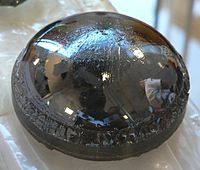
Photo from wikipedia
Zinc Oxide is widely used in many industrial sectors, ranging from photocatalysis, rubber, ceramic, medicine, and pigment, to food and cream additive. The global market is estimated to be USD… Click to show full abstract
Zinc Oxide is widely used in many industrial sectors, ranging from photocatalysis, rubber, ceramic, medicine, and pigment, to food and cream additive. The global market is estimated to be USD 3600M yearly, with a global production of 10 Mt. In novel applications, size and shape may sensibly increase the efficiency and a new nano-ZnO market is taking the lead (USD 2000M yearly with a capacity of 1 Mt and an expected Compound Annual Growth Rate of 20%/year). The aim of this work was to investigate the possibility of producing zinc oxide nanoparticles by means of a spinning disk reactor (SDR). A lab-scale spinning disk reactor, previously used to produce other nanomaterials such as hydroxyapatite or titania, has been investigated with the aim of producing needle-shaped zinc oxide nanoparticles. At nanoscale and with this shape, the zinc oxide particles exhibit their greatest photoactivity and active area, both increasing the efficiency of photocatalysis and ultraviolet (UV) absorbance. Working at different operating conditions, such as at different disk rotational velocity, inlet distance from the disk center, initial concentration of Zn precursor and base solution, and inlet reagent solution flowrate, in certain conditions, a unimodal size distribution and an average dimension of approximately 56 nm was obtained. The spinning disk reactor permits a continuous production of nanoparticles with a capacity of 57 kg/d, adopting an initial Zn-precursor concentration of 0.5 M and a total inlet flowrate of 1 L/min. Product size appears to be controllable, and a lower average dimension (47 nm), adopting an initial Zn-precursor concentration of 0.02 M and a total inlet flow-rate of 0.1 L/min, can be obtained, scarifying productivity (0.23 kg/d). Ultimately, the spinning disk reactor qualifies as a process-intensified equipment for targeted zinc oxide nanoparticle production in shape in size.
Journal Title: Nanomaterials
Year Published: 2020
Link to full text (if available)
Share on Social Media: Sign Up to like & get
recommendations!